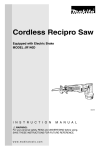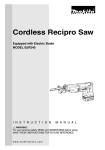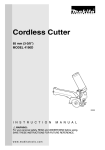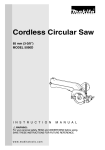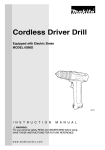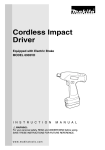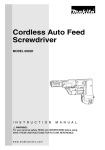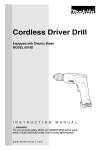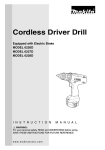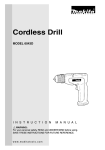Download Makita 4390D Specifications
Transcript
Cordless Recipro Saw MODEL 4390D I N S T R U C T I O N M A N U A L WARNING: For your personal safety, READ and UNDERSTAND before using. SAVE THESE INSTRUCTIONS FOR FUTURE REFERENCE. w w w. m a k i t a t o o l s . c o m SPECIFICATIONS Model 4390D Length of stroke 15 mm (9/16”) Soft wood 24 mm (15/16”) Hard wood 12 mm (1/2”) Pipe (Outer dia. x Thickness) 40 mm x 2 mm (1-5/8” x 5/64”) Max. cutting capacities Strokes per minute 2,700/min. Overall length 343 mm (13-1/2”) Net weight 1.4 kg (3.1 lbs) Battery Cartridge 9000 Battery Charger DC9700A Voltage Input Output Charging time 9.6 V A. C. only 50 Hz - 60 Hz D.C.7.2 V - 9.6 V 1 Hr. • Manufacturer reserves the right to change specifications without notice. • Specifications may differ from country to country. GENERAL SAFETY RULES USA003-1 (FOR All BATTERY OPERATED TOOLS) WARNING: Read and understand all instructions. Failure to follow all instructions listed below, may result in electric shock, fire and/or serious personal injury. SAVE THESE INSTRUCTIONS Work Area 1. Keep your work area clean and well lit. Cluttered benches and dark areas invite accidents. 2 2. Do not operate power tools in explosive atmospheres, such as in the presence of flammable liquids, gases, or dust. Power tools create sparks which may ignite the dust or fumes. 3. Keep bystanders, children, and visitors away while operating a power tool. Distractions can cause you to lose control. Electrical Safety 4. A battery operated tool with integral batteries or a separate battery pack must be recharged only with the specified charger for the battery. A charger that may be suitable for one type of battery may create a risk of fire when used with another battery. 5. Use battery operated tool only with specifically designated battery pack. Use of any other batteries may create a risk of fire. Personal Safety 6. Stay alert, watch what you are doing, and use common sense when operating a power tool. Do not use tool while tired or under the influence of drugs, alcohol, or medication. A moment of inattention while operating power tools may result in serious personal injury. 7. Dress properly. Do not wear loose clothing or jewelry. Contain long hair. Keep your hair, clothing, and gloves away from moving parts. Loose clothes, jewelry, or long hair can be caught in moving parts. 8. Avoid accidental starting. Be sure switch is in the locked or off position before inserting battery pack. Carrying tools with your finger on the switch or inserting the battery pack into a tool with the switch on invites accidents. 9. Remove adjusting keys or wrenches before turning the tool on. A wrench or a key that is left attached to a rotating part of the tool may result in personal injury. 10. Do not overreach. Keep proper footing and balance at all times. Proper footing and balance enable better control of the tool in unexpected situations. 11. Use safety equipment. Always wear eye protection. Dust mask, non-skid safety shoes, hard hat, or hearing protection must be used for appropriate conditions. Tool Use and Care 12. Use clamps or other practical way to secure and support the workpiece to a stable platform. Holding the work by hand or against your body is unstable and may lead to loss of control. 13. Do not force tool. Use the correct tool for your application. The correct tool will do the job better and safer at the rate for which it is designed. 14. Do not use tool if switch does not turn it on or off. A tool that cannot be controlled with the switch is dangerous and must be repaired. 15. Disconnect battery pack from tool or place the switch in the locked or off position before making any adjustments, changing accessories, or storing the tool. Such preventive safety measures reduce the risk of starting the tool accidentally. 16. Store idle tools out of reach of children and other untrained persons. Tools are dangerous in the hands of untrained users. 17. When battery pack is not in use, keep it away from other metal objects like: paper clips, coins, keys, nails, screws, or other small metal objects that can make a connection from one terminal to another. Shorting the battery terminals together may cause sparks, burns, or a fire. 18. Maintain tools with care. Keep cutting tools sharp and clean. Properly maintained tools with sharp cutting edge are less likely to bind and are easier to control. 19. Check for misalignment or binding of moving parts, breakage of parts, and any other condition that may affect the tool’s operation. If damaged, have the tool serviced before using. Many accidents are caused by poorly maintained tools. 20. Use only accessories that are recommended by the manufacturer for your model. Accessories that may be suitable for one tool may create a risk of injury when used on another tool. 3 SERVICE 21. Tool service must be performed only by qualified repair personnel. Service or maintenance performed by unqualified personnel may result in a risk of injury. 22. When servicing a tool, use only identical replacement parts. Follow instructions in the Maintenance section of this manual. Use of unauthorized parts or failure to follow Maintenance instructions may create a risk of shock or injury. SPECIFIC SAFETY RULES USB029-2 DO NOT let comfort or familiarity with product (gained from repeated use) replace strict adherence to cordless recipro saw safety rules. If you use this tool unsafely or incorrectly, you can suffer serious personal injury. 1. Hold tool by insulated gripping surfaces when performing an operation where the cutting tool may contact hidden wiring. Contact with a “live” wire will make exposed metal parts of the tool “live” and shock the operator. 2. Be aware that this tool is always in an operating condition, because it does not have to be plugged into an electrical outlet. 3. Always use safety glasses or goggles. Ordinary eye or sun glasses are NOT safety glasses. 4. Avoid cutting nails. Inspect workpiece for any nails and remove them before operation. 5. Do not cut oversize workpiece. 6. Check for the proper clearance beyond the workpiece before cutting so that the blade will not strike the floor, workbench, etc. 7. Hold the tool firmly. 8. Make sure the blade is not contacting the workpiece before the switch is turned on. 9. Keep hands away from moving parts. 4 10. Always switch off and wait for the blade to come to a complete stop before removing the blade from the workpiece. 11. Do not touch the blade or the workpiece immediately after operation; they may be extremely hot and could burn your skin. 12. Some material contains chemicals which may be toxic. Take caution to prevent dust inhalation and skin contact. Follow material supplier safety data. SAVE THESE INSTRUCTIONS WARNING: MISUSE or failure to follow the safety rules stated in this instruction manual may cause serious personal injury. IMPORTANT SAFETY INSTRUCTIONS FOR CHARGER & BATTERY CARTRIDGE USC001-3 1. SAVE THESE INSTRUCTIONS - This manual contains important safety and operating instructions for battery charger. 6. To reduce risk of damage to electric plug and cord, pull by plug rather than cord when disconnecting charger. 2. Before using battery charger, read all instructions and cautionary markings on (1) battery charger, (2) battery, and (3) product using battery. 7. Make sure cord is located so that it will not be stepped on, tripped over, or otherwise subjected to damage or stress. 3. CAUTION - To reduce risk of injury, charge only MAKITA rechargeable batteries marked on the charger label. Other types of batteries may burst causing personal injury and damage. 4. Do not expose charger to rain or snow. 5. Use of an attachment not recommended or sold by the battery charger manufacturer may result in a risk of fire, electric shock, or injury to persons. 8. An extension cord should not be used unless absolutely necessary. Use of improper extension cord could result in a risk of fire and electric shock. If extension cord must be used, make sure: a. That pins on plug of extension cord are the same number, size, and shape as those of plug on charger; b. That extension cord is properly wired and in good electrical condition; c. That wire size is at least as large as the one specified in the table below. Table 1: RECOMMENDED MINIMUM AWG SIZE FOR EXTENSION CORDS FOR BATTERY CHARGERS Length of Cord (Feet) 25 50 100 150 AWG Size of Cord 18 18 18 16 9. Do not operate charger with damaged cord or plug - replace them immediately. 10. Do not operate charger if it has received a sharp blow, been dropped, or otherwise damaged in any way; take it to a qualified serviceman. 11. Do not disassemble charger or battery cartridge; take it to a qualified serviceman when service or repair is required, Incorrect reassembly may result in a risk of electric shock or fire. 5 12. To reduce risk of electric shock, unplug charger from outlet before attempting any maintenance or cleaning. Turning off controls will not reduce this risk. 15. If operating time has become excessively shorter, stop operating immediately. It may result in a risk of overheating, possible burns and even an explosion. 13. The battery charger is not intended for use by young children or infirm persons without supervision. 16. If electrolyte gets into your eyes, rinse them out with clear water and seek medical attention right away. It may result in loss of your eyesight. 14. Young children should be supervised to ensure that they do not play with the battery charger. ADDITIONAL SAFETY RULES FOR CHARGER & BATTERY CARTRIDGE 1. Do not charge Battery Cartridge when temperature is BELOW 10°C (50°F) or ABOVE 40°C (104°F). 6. Do not store the tool and Battery Cartridge in locations where the temperature may reach or exceed 50°C (122°F). 2. Do not attempt to use a step-up transformer, an engine generator or DC power receptacle. 7. Do not incinerate the Battery Cartridge even if it is severely damaged or is completely worn out. The battery cartridge can explode in a fire. 3. Do not allow anything to cover or clog the charger vents. 4. Always cover the battery terminals with the battery cover when the battery cartridge is not used. 5. Do not short the battery cartridge: (1) Do not touch the terminals with any conductive material. (2) Avoid storing battery cartridge in a container with other metal objects such as nails, coins, etc. (3) Do not expose battery cartridge to water or rain. A battery short can cause a large current flow, overheating, possible burns and even a breakdown. 6 8. Be careful not to drop, shake or strike battery. 9. Do not charge inside a box or container of any kind. The battery must be placed in a well ventilated area during charging. FUNCTIONAL DESCRIPTION • 002481 1 Installing or removing battery cartridge • Always switch off the tool before insertion or removal of the battery cartridge. • To remove the battery cartridge, pull out the set plate on the tool and grasp both sides of the cartridge while withdrawing it from the tool. • To insert the battery cartridge, align the tongue on the battery cartridge with the groove in the housing and slip it into place. Snap the set plate back into place. Be sure to close the set plate fully before using the tool to prevent the battery cartridge from accidentally falling out of the tool. • Do not use force when inserting the battery cartridge. If the cartridge does not slide in easily, it is not being inserted correctly. 2 1. Set plate 2. Battery cartridge 001332 1 1. Charging light CAUTION: Always be sure that the tool is switched off and the battery cartridge is removed before adjusting or checking function on the tool. Charging 1. Plug the battery charger into the proper AC voltage source. 2. Insert the battery cartridge so that the plus and minus terminals on the battery cartridge are on the same sides as their respective markings on the charger. Insert the cartridge fully into the port so that it rests on the charger port floor. 3. When the battery cartridge is inserted, the charging light color will flash in red color and charging will begin. 4. When the charging light goes out after about one hour, you may remove the fully charged battery cartridge. 5. After charging, unplug the charger from the power source. NOTE: • The battery charger is for charging Makita battery cartridge. Never use it for other purposes or for other manufacturer’s batteries. 7 • If you try to charge a battery cartridge from a just operated tool, sometimes the charging light will not come on. If this occurs, let the cartridge cool off for a while. Then re-insert it and try to charge it once more. • When you charge a new battery cartridge or a battery cartridge which has not been used for a long period of time, it may not accept a full charge. This is a normal condition and does not indicate a problem. You can recharge the battery cartridge fully after discharging it completely and recharging a couple of times. • When you charge a new battery cartridge or a battery cartridge which has not been used for a long period, sometimes the charging light will go out soon. If this occurs, remove the battery cartridge and re-insert it. If the charging light goes out within one minute even after repeating this procedure a couple of times, the battery cartridge is dead. Replace it with a new one. • If you wish to charge two battery cartridges, allow 15 minutes between charging on the charger. Tips for maintaining maximum battery life 1. Charge the battery cartridge before completely discharged. Always stop tool operation and charge the battery cartridge when you notice less tool power. 2. Never recharge a fully charged battery cartridge. Overcharging shortens the battery service life. 3. Charge the battery cartridge with room temperature at 10°C - 40°C (50°F - 104°F). Let a hot battery cartridge cool down before charging it. 002490 Switch action • 1 2 1. Lock-off lever 2. Switch trigger 8 CAUTION: Before inserting the battery cartridge into the tool, always check to see that the switch trigger actuates properly and returns to the “OFF” position when released. To prevent the switch trigger from being accidentally pulled, a lock-off lever is provided. To start the tool, slide the lock-off lever in the direction of the arrow and pull the switch trigger. Release the switch trigger to stop. ASSEMBLY • 002498 Installing or removing saw blade 1 2 • 3 CAUTION: Always clean out all chips or foreign matter adhering to the blade, blade clamp and/or slider. Failure to do so may cause insufficient tightening of the blade, resulting in a serious injury. To install the blade, loosen the bolt on the blade clamp with the hex wrench. Keep the back edge of the blade against the roller and insert the blade between the blade clamp and the slider as far as it will go. Make sure that you are inserting the blade into the proper position. 1. Roller 2. Blade clamp 3. Blade installing position 002499 1 Fit the pin on the slider into the hole in the blade shank. NOTE: 2 3 • 4 5 6 1. 2. 3. 4. 5. 6. CAUTION: Always be sure that the tool is switched off and the battery cartridge is removed before carrying out any work on the tool. The hole in the blade shank will be aligned with the pin on the slider when the blade shank hits against the spring pin on the slider. After the pin fits properly into the hole, tighten the bolt clockwise securely while making sure that the blade cannot be extracted even though you try to pull it out. Blade clamp Slider Spring pin Pin Blade shank Hole 002500 3 1 4 5 6 2 1. 2. 3. 4. 5. 6. Slider Hex wrench Roller Blade Blade clamp Shoe CAUTION: • If you tighten the bolt without the pin on the slider fitting properly in the hole in the blade shank, the pin or the blade shank will be damaged. This may cause the blade to be extracted unexpectedly during operation. To remove the blade, follow the installation procedure in reverse. 9 002512 Hex wrench storage When not in use, store the hex wrench as shown in the figure to keep it from being lost. 1 1. Hex wrench OPERATION • 002513 CAUTION: Always press the shoe firmly against the workpiece during operation. If the shoe is held away from the workpiece during operation, strong vibration and/or twisting will be produced, causing the blade to snap dangerously. • Always wear gloves to protect your hands from hot flying chips when cutting metal. • Be sure to always wear suitable eye protection which conforms with current national standards. • Always use a suitable coolant (cutting oil) when cutting metal. Failure to do so will cause premature blade wear. Press the shoe firmly against the workpiece. Do not allow the tool to bounce. Bring the blade into light contact with the workpiece. Turn the tool on and wait until the blade attains full speed. Then apply pressure to cut the workpiece. NOTE: • MAINTENANCE • If the tool is operated continuously until the battery cartridge has discharged, allow the tool to rest for 15 minutes before proceeding with a fresh battery. CAUTION: Always be sure that the tool is switched off and the battery cartridge is removed before attempting to perform inspection or maintenance. To maintain product SAFETY and RELIABILITY, repairs, any other maintenance or adjustment should be performed by Makita Authorized or Factory Service Centers, always using Makita replacement parts. 10 EN0001-1 Recycling the Battery The only way to dispose of a Makita battery is to recycle it. The law prohibits any other method of disposal. To recycle the battery: 1. Remove the battery from the tool. Ni-Cd 2. a) Take the battery to your nearest Makita Factory Service Center or b) Take the battery to your nearest Makita Authorized Service Center or Distributor that has been designated as a Makita battery recycling location. Call your nearest Makita Service Center or Distributor to determine the location that provides Makita battery recycling. See your local Yellow Pages under “Tools-Electric”. ACCESSORIES • These accessories or attachments are recommended for use with your Makita tool specified in this manual. The use of any other accessories or attachments might present a risk of injury to persons. Only use accessory or attachment for its stated purpose. If you need any assistance for more details regarding these accessories, ask your local Makita service center. • Recipro saw blades • Various type of Makita genuine batteries and chargers • Hex wrench 3 11 Memo 12 Cut First-Class Postage Required Post Office will not deliver without proper postage. Makita U.S.A., Inc. 14930 Northam Street La Mirada, CA 90638-5753 Fold 13 MAIL THIS PORTION Your answers to the following questions are appreciated. 1. This product was purchased from: 3. How did you learn about this product: Other ( Magazine Radio Hardware/Lumber Store From Dealer Exhibition Tool Distributor Newspaper From Friend Industrial Supply Store Display Previous Usage Construction Supply Catalog Other ( Home Center ) 2. Use of the product is intended for: ) 4. Most favored points are: Construction Trade Design Repair Service Industrial Maintenance Features Durability Home Maintenance Size Power Hobby Price Other ( Other ( ) ) Makita Brand 5. Any comments: Paste MODEL NO. DAY YEAR SERIAL NO. SEX STATUS INTL. LAST NAME / COMPANY NAME Married Single M F STREET ADRESS Paste MONTH Paste Paste Paste Paste DATE PURCHASED Under 19 AREA CODE PHONE 20-29 30-39 Paste AGE: ZIP CODE 40-49 50-60 Over 60 Paste Paste STATE Paste CITY Paste Paste BE SURE TO COMPLETE THE CUSTOMER’S PORTION OF THIS FORM AND RETAIN FOR YOUR RECORDS. Please return this portion by facsimile or mail. 14 Facsimile No: (714) 522-8133 Paste Paste Paste Paste Paste Paste Paste Paste FACTORY SERVICE CENTERS 1-800-4-MAKITA RETAIN THIS PORTION FOR YOUR RECORDS ALABAMA 2365 Pelham Parkway Pelham, AL 35124 (205) 620-1791 COLORADO 11839 E. 51st Ave. Denver, CO 80239-2709 (303) 371-2850 KENTUCKY 1215 S. Hurstbourne Parkway Louisville, KY 40222 (502) 326-3740 NEW MEXICO 5805 Menaul Blvd. NE Albuquerque, NM 87110 (505) 881-4619 PUERTO RICO 200 Guayama St. Hato Rey, PR 00917 (787) 250-8776 ARIZONA 3707 E. Broadway Rd., Ste. 6 Phoenix, AZ 85040 (602) 437-2850 CONNECTICUT 508 Spring St. Windsor Locks, CT 06096 (860) 292-6405 LOUSIANA 5626 Jefferson Hwy. Harahan, LA 70123 (504) 733-4138 NEW YORK 4917 Genessee Street Cheektowaga, NY 14225 (716) 685-9503 TENNESSEE 4655 Nolensville Rd. Nashville, TN 37211 (615) 331-9922 ARKANSAS Shackleford Shopping Center 240 South Shackleford Rd., Ste. C Little Rock, AR 72211 (501) 224-5733 FLORIDA 620 Douglas Ave. Suite 1302 Altamonte Springs, FL 32714 (407) 774-6000 MARYLAND 7541 - 45 Ritchie Highway Glen Burnie, MD 21061 (410) 590-0160 CALIFORNIA 41850 Christy St. Fremont, CA 94538-5107 (510) 657-9881 1421 N. Clovis Ave., Ste. 112 Fresno, CA 93727 (559) 252-5166 14930 Northam St. La Mirada, CA 90638-5753 (714) 522-8088 1970 Fulton Avenue Sacramento, CA 95825 (916) 482-5197 1440 South “E” Street San Bernardino, CA 92408 (909) 885-1289 7674 Clairemont Mesa Blvd. San Diego, CA 92111 (858) 278-4471 1714 E.McFadden Ave., Unit M Santa Ana, CA 92705 (714) 667-5066 1565 Winchester B. Campbell, CA 95008-0501 (408) 379-0377 16735 Saticoy St., Ste. 105 Van Nuys, CA 91406 (818) 782-2440 750 East Sample Road Pompano Beach, FL 33064 (954) 781-6333 Thompson Center Waters 5501 W. Waters Ave., Ste. 406 Tampa, FL 33634 (813) 886-8292 GEORGIA 4680 River Green Parkway Duluth, GA 30096-2566 (770) 476-8911 HAWAII 4510 Salt Lake Blvd., Suite A7 Honolulu, HI 96818 (808) 847-0038 ILLINOIS 1450 Feehanville Dr. Mt. Prospect, IL 60056-6011 (847) 297-3100 INDIANA 8403 Michigan Road, Unit 1 Indianapolis, IN 46268 (317) 334-9980 KANSAS 8819 W. 95th St. Overland Park, KS 66212 (913) 642-1111 MASSACHUSETTS 232 Providence Hwy. Westwood, MA 02090 (617) 461-9754 MICHIGAN 37454 Ann Arbor Trail Livonia, MI 48150 (313) 432-1012 131-35 31st Ave. Flushing, NY 11354 (718) 886-0971 NORTH CAROLINA 3501-G S. Tryon St. Charlotte, NC 28217 (704) 527-0611 OHIO 6253 E. Main St. Columbus, OH 43213 (614) 860-0222 6379 Pearl Road Parma Heights, OH 44130 (440) 843-7555 MINNESOTA 6427 Penn Ave. South Richfield, MN 55423 (612) 869-5199 1617 E. Kemper Rd. Sharonville, OH 45246 (513) 771-0788 MISSOURI 9876 Watson Road St. Louis, MO 63126-2221 (314) 909-9889 OKLAHOMA 552 E. Memorial Road Oklahoma City, OK 73114 (405) 752-2655 NEBRASKA 4129 S. 84th St. Omaha, NE 68127 (402) 597-2925 OREGON 828 19th Avenue., N.W. Portland, OR 97209 (503) 222-1823 NEVADA 3375 S. Decatur Blvd. Suites. 22 - 24 Las Vegas, NV 89102 (702) 368-4277 PENNSYLVANIA Springwater Plaza 364 Wilmington W. Chester Pike Glen Mills, PA 19342 (610) 459-4122 NEW JERSEY 251 Herrod Blvd. Dayton, NJ 08810-1539 (609) 655-1212 6200 Babcock Blvd Pittsburgh, PA 15237 (412) 366-6363 TEXAS 12801 Stemmons Fwy Ste. 809 Farmers Branch, TX 75234 (972) 243-1150 12701 Directors Dr. Stafford, TX 77477-3701 (281) 565-8665 3453 IH-35 North, Ste. 101 San Antonio, TX 78219 (210) 228-0676 UTAH 145 E. 1300 S., Ste. 101 Salt Lake City, UT 84115 (801) 359-3410 VIRGINIA 5760 Northampton Blvd,. Ste. 102 Virginia Beach, VA 23455 (757) 460-0280 WASHINGTON 22220 84th Ave. So., Bldg. A Kent, WA 98032 (253) 395-8055 WISCONSIN Lincoln Plaza Shopping Ctr. 2245 S. 108th St. West Allis, WI 53227 (414) 541-4776 CUSTOMER’S RECORD When you need service: Send complete tool (prepaid) to one of the Makita Factory Service Centers listed, or to an Authorized Makita Service Center. Be sure to attach a letter to the outside of the carton detailing the problem with your tool. Date Purchased Dealer’s Name & Address Model No. Serial No. 15 WARNING Some dust created by power sanding, sawing, grinding, drilling, and other construction activities contains chemicals known to the State of California to cause cancer, birth defects or other reproductive harm. Some examples of these chemicals are: • lead from lead-based paints, • crystalline silica from bricks and cement and other masonry products, and • arsenic and chromium from chemically-treated lumber. Your risk from these exposures varies, depending on how often you do this type of work. To reduce your exposure to these chemicals: work in a well ventilated area, and work with approved safety equipment, such as those dust masks that are specially designed to filter out microscopic particles. MAKITA LIMITED ONE YEAR WARRANTY Warranty Policy Every Makita tool is thoroughly inspected and tested before leaving the factory. It is warranted to be free of defects from workmanship and materials for the period of ONE YEAR from the date of original purchase. Should any trouble develop during this one-year period, return the COMPLETE tool, freight prepaid, to one of Makita's Factory or Authorized Service Centers. If inspection shows the trouble is caused by defective workmanship or material, Makita will repair (or at our option, replace) without charge. This Warranty does not apply where: • repairs have been made or attempted by others: • repairs are required because of normal wear and tear: • the tool has been abused, misused or improperly maintained: • alterations have been made to the tool. IN NO EVENT SHALL MAKITA BE LIABLE FOR ANY INDIRECT, INCIDENTAL OR CONSEQUENTIAL DAMAGES FROM THE SALE OR USE OF THE PRODUCT. THIS DISCLAIMER APPLIES BOTH DURING AND AFTER THE TERM OF THIS WARRANTY. MAKITA DISCLAIMS LIABILITY FOR ANY IMPLIED WARRANTIES, INCLUDING IMPLIED WARRANTIES OF "MERCHANTABILITY" AND "FITNESS FOR A SPECIFIC PURPOSE," AFTER THE ONE-YEAR TERM OF THIS WARRANTY. This Warranty gives you specific legal rights, and you may also have other rights which vary form state to state. Some states do not allow the exclusion or limitation of incidental or consequential damages, so the above limitation or exclusion may not apply to you. Some states do not allow limitation on how long an implied warranty lasts, so the above limitation may not apply to you. Makita Canada Inc. 1950 Forbes Street, Whitby, Ontario L1N 7B7 883604J063
















